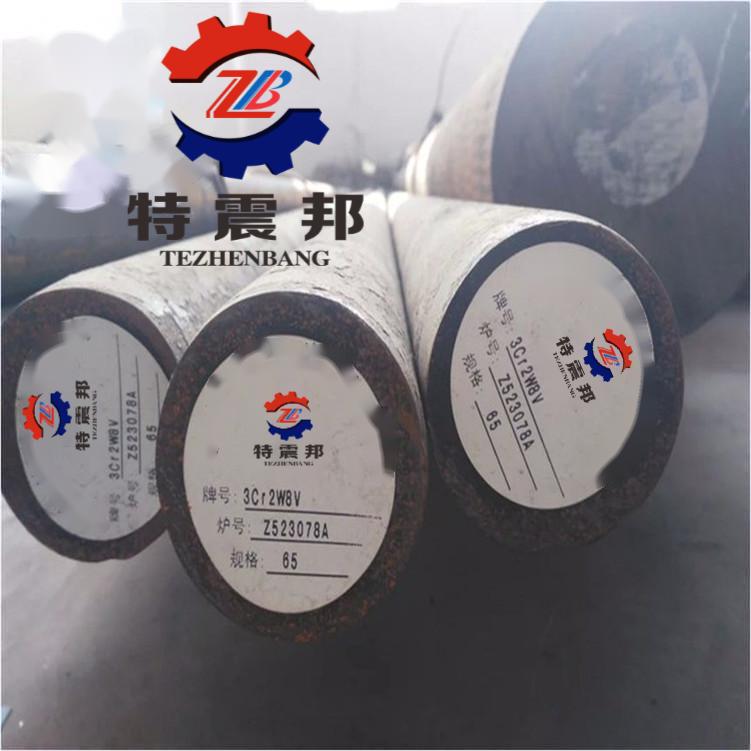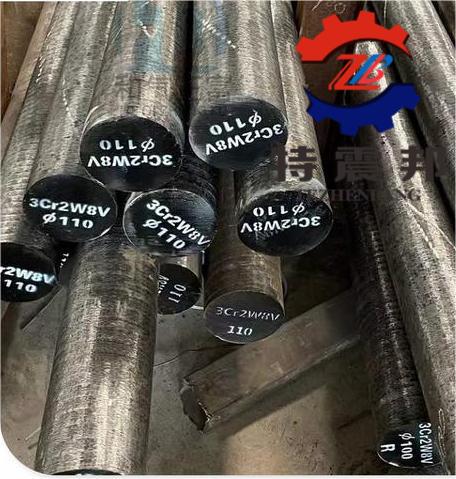Detailed Introduction
| Steel Grade (GB) |
Comparison of Grades from Various Countries |
Technical Conditions |
Chemical Composition |
||||||||||||||
| C |
Cr |
Mo |
V |
S |
P |
Si |
Mn |
Ni |
W |
Al |
Cu |
Nb |
Co |
B |
|||
| 3Cr2W8V |
Germany (1.2581) USA (H21) Japan (SKD5)
|
GB/T 1299-77 |
0.30 ¦ 0.40 |
2.20 ¦ 2.70 |
|
0.20 ¦ 0.50 |
≤0.030 |
≤0.030 |
≤0.40 |
≤0.40 |
|
7.50 ¦ 9.00 |
|
|
|
|
|
Basic Information
3Cr2W8V die steel is a tungsten-based high heat strength steel.Hot Work Die SteelIt is a representative steel grade, with tungsten as the main alloying element, and the tungsten mass fraction reaching over 8%. This steel has been the most widely used typical die-casting steel in China for a long time and can also be used in other hot work dies. Although it is prone to cold and hot fatigue cracks under rapid heating and cooling conditions due to its poor resistance to thermal fatigue, making it unsuitable for such conditions, it has a relatively high tempering resistance and can still be used as a high heat strength hot work die steel in many hot processing fields.
The critical points of 3Cr2W8V die steel are Ac1830℃, Ac3920℃, Ar3838℃, Ar1773℃, Ms350℃, Mf1620℃.
Mechanical Properties
At room temperature, the mechanical properties of 3Cr2W8V die steel show a secondary hardening peak around 550℃ during tempering, with a low point in impact toughness appearing around 650℃ tempering.Cross-sectional Shrinkage RateA valley also appears.High Temperature Mechanical PropertiesThe high temperature strength, high temperature impact toughness, and high temperature hardness of 3Cr2W8V steel after different processing methods are shown in the table below.
Process Performance
Forging: The heating temperature of the steel blank is 1130-1160℃, the initial forging temperature is 1080-1120℃, the final forging temperature is 850-900℃, and it is air-cooled to 700℃ and then slowly cooled. Annealing: Isothermal annealing heating temperature is 840-880℃, isothermal temperature is 720-740℃, and annealing hardness is ≤241HBS. Quenching and Tempering: Quenching temperature is 1050-1150℃, oil cooling, quenching hardness is 50-54HRC. Tempering temperature is 550-650℃ for two times, each for 2 hours, tempering hardness is 40-502HRC.
Practical Applications of 3Cr2W8V Die Steel
3Cr2W8V die steel has a low tendency for decarburization and deformation during quenching heating. Currently, the production volume in steel mills is still large, and the heat treatment equipment and processes are relatively stable, with many small and medium-sized machinery factories still widely using it. Due to its high heat resistance, it is widely used in many areas such as forging dies for presses, hot extrusion dies, upsetting dies, shearing knives, die-casting molds, precision forging molds, and non-ferrous metal forming molds.
1. Used to make stepped blanks for forging, with the forged workpiece material being Cr18Ni10. The service life of this flat forging concave die is 1000 times.
2. Used to make hot extrusion concave dies. When the hardness is 45-50HRC, early fracture is likely to occur, and the service life is not high. When the hardness is 38-40HRC, early fracture is less likely to occur, and the average service life is significantly improved.
3. Widely used for die-casting molds, convex and concave molds, or inserts that operate at temperatures in the range of 600-650℃, with a recommended hardness of 48-52HRC.
4. When using this steel for forging high heat strength steel forgings, it can replace 5CrMnMo steel, increasing the mold's service life from less than 200 pieces to about 1000 pieces.
5. Molds made from this steel, using gas carburizing furnaces orsolid carburizing agentsfor protective heating and quenching, are prone to surface decarburization layers with a thickness of 0.5-2.0mm, and the carbon mass fraction can reach 0.7%-1.0%, which can easily lead to early thermal fatigue cracking. After surface carbon increase in cold work molds, failure modes mainly include edge chipping and brittle fracture.
6. Used to make convex and concave molds that work under high temperature and high stress but are not subjected to impact loads, such as concave and convex molds on flat forging machines, copper alloy extrusion molds, and die-casting molds.
7. Can be used as hot shearing knives working at high temperatures.
8. This steel is used to makebearing ringsfor hot upset forging punches, at a speed of 80-100 times/min on high-speed upset forging machines, with water cooling applied to the punches during service. The punch hardness is 50HRC, and the service life is 1500 times, which is less than that of 4Cr5MoSiV steel.
9. The service life of aluminum extrusion molds made from 3Cr2W8V die steel is increased by 1-3 times after high temperature quenching and medium temperature tempering treatment.
10. The service life of 3Cr2W8V die steel needle-nose pliers hot forging molds (size 75mm×75mm×105mm) is increased from the original 4000 pieces to 20000 pieces after isothermal quenching in bainite and then undergoing a shaping treatment at 360℃ for 4 hours.
11. 3Crr2W8V mold steel large cross-section hot extrusion mold (80-10mm), after isothermal quenching treatment, tempering hardness is 48-50HRC, the core structure is a mixed structure of martensite + lower bainite, and the mold service life is 3000 pieces. Increased by more than 2 times.


key word:
Hot working mold steel
Cold working mold steel
Plastic mold steel
Forging series
Message Consultation
Service hotline:
Company address
Telephone
Address: No.128 Zhangzhihe Avenue, Dapaishan Village, Xisaishan District, Huangshi City, Hubei Province

